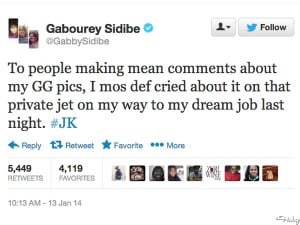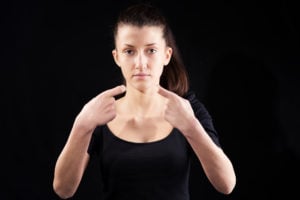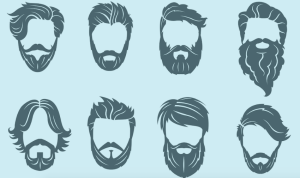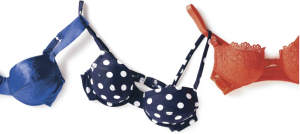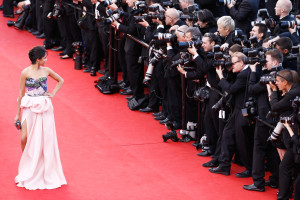
Source: Pix Shark
An actress arrives at the Academy Awards – or any awards show or movie premiere – and steps onto the red carpet.
A microphone is held up to her face. And the first – and quite possibly only – question she is asked is “Who are you wearing?”
Immediately, she is transformed into a walking, talking advertisement for a fashion designer, the red carpet reduced from a place of honor for an accomplished woman in contention for a prestigious award to a Fashion Week runway.
The Academy Awards are supposed to be an opportunity for actors and actresses to be honored for their work in film.
It is, as they say, an honor just to be nominated. An honor that will, at least for the women, likely be completely overshadowed before, during, and after the event by discussions of what they wear and how they look.
Their bodies, clothes, manicures, and purses will be scrutinized and criticized on television, print media, and the Internet.
So-called fashion experts will weigh in on the style choices. They will compile best- and worst-dressed lists. And hoards of women will take to the Internet in droves to say mean things about actresses’ bodies and what they put on them in the comment sections.
This will serve to reinforce, in the strongest possible way, the notion that the way that women look is far more important than what we achieve.
And this fact will be pointed out by any number of people, all of whom will be met by a rather stunning amount of denial and justification.
“It’s not about shaming the actresses,” they tell us. “It’s about fashion” – as if we shouldn’t look at the ways in which fashion can be used to oppress women in general, as well as intersectionally along lines of race, class, size, gender, and dis/ability.
For example, women of color – when they are nominated at all – face not just the gauntlet of being compared to a standard of beauty that is only fully achievable through photo manipulation, but to a heaping helping of respectability politics as well.
Fat women, on the other hand, are reminded that fat is a master status that will forever overshadow anything that they could achieve, and that self-deprecation is expected – as is wearing clothing chosen for no other reason that it creates the illusion than they look different than they do.
And can you recall the last time an actress rolled the red carpet in a wheelchair, or walked using a mobility device?
It’s not just actors and actresses parading down those runways, but our narrow standards of beauty – white, thin, cis-gendered, currently able-bodied – too.
And those who don’t meet the standard are either excluded or are told – explicitly or implicitly – that they deserve stern criticism for their “shortcomings.”
Oppression from Every Intersectional Direction
Take singer and Disney star Zendaya Coleman for instance, who walked the red carpet in locs that Fashion Police and E! News host Guiliana Rancic said looked like “they smell like patchouli oil and weed.”
Zendaya responded on Twitter:
“[T]o say that an 18 year-old young woman with locs must smell like patchouli or ‘weed’ is not only a large stereotype, but outrageously offensive. […] There is already harsh criticism of African American hair in Hollywood without the help of ignorant people who choose to judge others based on the curl of their hair. My wearing my hair in locs on an Oscar Red Carpet was to showcase them in a positive light, to remind people of color that our hair is good enough.”
Rancic later took responsibility and apologized, while E! tried to justify the mess saying that a “black senior producer” hadn’t cut the joke.
And racism is just the start!
In an interview discussing why she’s starting her own fashion line, Melissa McCarthy said, “When I go shopping, most of the time, I’m disappointed.
Two Oscars ago, I couldn’t find anybody to do a dress for me. I asked five or six designers – very high-level ones who make lots of dresses for people – and they all said no.”
These are designers who fight tooth and nail to get their dresses on actresses walking the red carpet at the Oscars.
Yet they refused to dress a plus-sized woman, despite the fact that the majority of women in the country wear plus sizes (or, as I like to call them, sizes) and that the woman asking them to dress her was an Academy Award nominee who was walking the same red carpet, getting the same attention, and being considered for the same honor as the thinner counterparts the designers were all but begging to wear their clothes.
When Gabourey Sidibe had the audacity to be Black, fat, wear a beautiful body hugging ivory gown, and walk the red carpet at the Golden Globes all at the same time, she got criticized for each of those things individually and in every possible combination – in everything from immature fat jokes to concern trolling about her health.
She responded with perhaps one of my favorite tweets of all the time:
And of course, this doesn’t take into account the lack of diversity in the Academy itself (in 2012, the Los Angeles Times found that of the almost 6,000 members of the Academy, 94% are white, 77% are male, and 86% are age 50 or older) and in the nominees (this year’s acting nominees didn’t include a single person of color, and the directorial nominees were all male).
No, They Weren’t Asking for It
Another very common justification for the poor treatment of actresses at awards shows is that the actresses deserve it because they are celebrities – and that they therefore “put themselves out there to be judged.”
This always seems to be tossed around with no commentary as to how that line of “logic” affects the millions of little girls who want to emulate celebrities, or the fact that it means we’re actually looking for reasons to justify objectifying women and reducing them to their appearance, instead of fighting it.
Not to mention that the people using this justification seem to completely forget that what these women are actually putting themselves out there to do is act – to tell stories and portray characters and use their talent.
And now they’re “putting themselves out there” because they’re so good at what they do that they’ve been nominated for an award.
Being a talented woman should not come with an inevitable side of fashion bashing and body snarking.
In fact, before 1961, there was no red carpet, no swarm of reporters – and nominated actresses showed up anyway to see if they had—you know—won the damn award.
I think that when we say, correctly, that a woman being in public is not an invitation to objectify her, that we should apply that to all women – including those nominated for awards because of their accomplishments at work.
And it’s not just the dresses that we use to reduce women to objects. Since 2012, E! Network has employed the “Mani Cam,” a tiny box with a red carpet inside that women put their hands in, thereby reducing them to merely the paint on a single body part.
Further, the “Clutch Cam” took the focus off talented women completely and put it where it obviously belongs – on their purses. Maybe next year we can having the “Earring Cam” – or, hey!, even just take it all the way with the “Tits and Ass Cam.”
How Actresses Are Pushing Back (And Why We Need to Support Them)
Things are changing, and a lot it is coming from the actresses themselves.
The “Mani Cam” got retired this year after it was publicly snubbed by actresses including Jennifer Aniston, Julianne Moore, and Reese Witherspoon, and in an epic moment when Elisabeth Moss waited for the camera to zoom in on her hand before extending her middle finger, causing reporter Julianna Rancic to desperately reach for her arm while Ms. Moss just smiled broadly.
Amy Poehler and Reese Witherspoon joined forces with The Representation Project to promote their online campaign #AskHerMore, calling on reporters to ask the women being honored more meaningful questions than the name on their dress tag.
Jennifer Lawrence responded to being asked “Tell us about the pieces you are wearing” by saying “What do you mean? Like, this is the top, and this is the bottom.”
And when a camera started at her feet and panned up, Cate Blanchett stooped down to interrupt the shot, pointed in the camera and said ,“Do you do that to the guys?” An excellent question all the way around.
By refusing to bow to the pressure of being complacent eye candy, these women are putting their careers on the line. And we should, at the very least, have their backs.
We set up a system in which we put celebrity women up on a pedestal, then claim that the fact that they’re up there makes it okay for us to judge them publicly and harshly. Then we tear them down off the pedestal in a bid to feel a little bit better about ourselves.
And why?
Because we live in a world where the diet and beauty industries make billions of dollars by making us feel like we’ll never be good enough because we’ll never measure up to – wait for it – celebrities.
And we haven’t even discussed the amazing singers, actors, dancers, and other entertainers we’ll never see because those in power choose entertainers for traits like being thin, white, young, cisgender, and currently able-bodied first, and talented second.
Meeting a stereotype of beauty becomes the ticket to entry for anyone to get to display their talent. And sooner or later, this machine of oppression hurts us all.
The good news is that it runs on our time, money, and energy – which means we can take the fuel away and bring the machine to a screeching halt.
Women should be able to be talented – including in ways that put them in the public eye – without being treated like pieces of well-dressed, well-manicured , clutch-carrying meat.
We should work to change the ways in which the fashion world oppresses women and contributes to racism, sizeism, ableism, ageism, and gender stereotypes.
Women should be able to dress up for special occasions without the occasion becoming about how they are dressed. We should be able to find a way to acknowledge the artistry of fashion designers without erasing the achievements of the women wearing their clothing.
And we can all be much more interested in asking women “Who are you?” than “Who are you wearing?”
***
To learn more about this topic, check out:
- From Stripping to Sex Tapes – The Kardashians, Amber Rose, and Our Love of Hating Women
- When Female Politicians Become Victims of Their Own Fashion
- How Women Are Pressured into Being Sexy, But Punished for Being Sexual
- How to Support Your Young, Indigenous Daughter in Fighting Hypersexualization
[do_widget id=”text-101″]
Ragen Chastain is a trained researcher, three-time National Champion dancer, and marathoner who writes and speaks full-time about self-esteem, body image, and health. Ragen is the author of the blog DancesWithFat and the book Fat: The Owner’s Manual, and her writing has been published in forums including the Huffington Post, Calgary Herald, Jezebel.com, and The Frisky.com. She is the editor of the multi-volume anthology The Politics of Size – Perspectives from the Fat Acceptance Movement, due out for Praeger in 2015. You can check her out on Twitter @danceswithfat.
Search our 3000+ articles!
Read our articles about:
Our online racial justice training
Used by hundreds of universities, non-profits, and businesses.
Click to learn more


